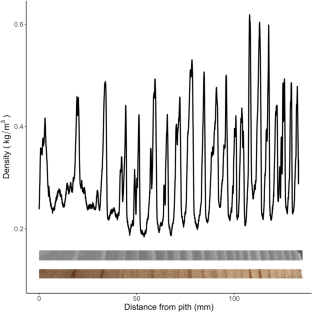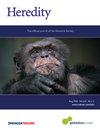Integrating environmental gradients into breeding: application of genomic reactions norms in a perennial species
IF 3.1
2区 生物学
Q2 ECOLOGY
引用次数: 0
Abstract
Global warming threatens the productivity of forest plantations. We propose here the integration of environmental information into a genomic evaluation scheme using individual reaction norms, to enable the quantification of resilience in forest tree improvement and conservation strategies in the coming decades. Random regression models were used to fit wood ring series, reflecting the longitudinal phenotypic plasticity of tree growth, according to various environmental gradients. The predictive ability of the models was considered to select the most relevant environmental gradient, namely a gradient derived from an ecophysiological model and combining trunk water potential and temperature. Even if the individual ranking was preserved over most of the environmental gradient, strong genotype x environment interactions were detected in the extreme unfavorable part of the gradient, which includes environmental conditions that are very likely to be more frequent in the future. Combining genomic information and longitudinal data allowed to predict the growth of individuals in environments where they have not been observed. Phenotyping of 50% of the individuals in all the environments studied allowed to predict the growth of the remaining 50% of individuals in all these environments with a predictive ability of 0.25. Without changing the total number of observations, adding observations in a reduced number of environments for the individuals to be predicted, while decreasing the number of individuals phenotyped in all environments, increased the predictive ability to 0.59, highlighting the importance of phenotypic data allocation. We found that genomic reaction norms are useful for the characterization and prediction of the function of genetic parameters and facilitate breeding in a climate change context.


将环境梯度纳入育种:基因组反应规范在多年生物种中的应用。
全球变暖威胁着人工林的生产力。在此,我们建议利用个体反应标准将环境信息整合到基因组评估方案中,以便在未来几十年的林木改良和保护战略中对恢复力进行量化。随机回归模型用于拟合木环序列,反映了树木生长在不同环境梯度下的纵向表型可塑性。考虑到模型的预测能力,我们选择了最相关的环境梯度,即由生态生理模型推导并结合树干水势和温度的梯度。即使在大部分环境梯度中保持了个体排序,但在梯度的极端不利部分仍发现了基因型与环境之间的强烈相互作用,其中包括未来很可能会更加频繁出现的环境条件。结合基因组信息和纵向数据,可以预测个体在未观察到的环境中的生长情况。对所有研究环境中 50%的个体进行表型分析后,可以预测所有环境中其余 50%个体的生长情况,预测能力为 0.25。在不改变观测数据总数的情况下,增加待预测个体在较少环境中的观测数据,同时减少在所有环境中进行表型的个体数量,可将预测能力提高到 0.59,这凸显了表型数据分配的重要性。我们发现,基因组反应规范有助于表征和预测遗传参数的功能,并促进气候变化背景下的育种工作。
本文章由计算机程序翻译,如有差异,请以英文原文为准。
求助全文
约1分钟内获得全文
求助全文
来源期刊

Heredity
生物-进化生物学
CiteScore
7.50
自引率
2.60%
发文量
84
审稿时长
4-8 weeks
期刊介绍:
Heredity is the official journal of the Genetics Society. It covers a broad range of topics within the field of genetics and therefore papers must address conceptual or applied issues of interest to the journal''s wide readership
 求助内容:
求助内容: 应助结果提醒方式:
应助结果提醒方式:


